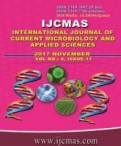


 National Academy of Agricultural Sciences (NAAS)
National Academy of Agricultural Sciences (NAAS)

|
PRINT ISSN : 2319-7692
Online ISSN : 2319-7706 Issues : 12 per year Publisher : Excellent Publishers Email : editorijcmas@gmail.com / submit@ijcmas.com Editor-in-chief: Dr.M.Prakash Index Copernicus ICV 2018: 95.39 NAAS RATING 2020: 5.38 |
An attempt has been made to prepare mango pickle using different salt compositions of NaCl, KCl and CaCl2 and evaluate the pickle samples for total bacterial population and Lactic acid bacteria populations. The purpose of salt mixture was to reduce Na consumption. The results showed that the total bacterial population tends to increase with storage. Minimum bacterial population was observed at 0 day and maximum at 210th day of storage. Among different treatments, T1 and T2 showed maximum bacterial population of 164 and 160 respectively, whereas minimum bacterial colonies was observed in T5 (147.67). It clearly indicates that CaCl2 has a negative influence on bacterial population. The Lactic Acid Bacteria population shows a reverse trend and tends to decline with storage time. At 0 day, T1 shows highest population of LAB (162.67) followed by T2 (139.67), T6 (137.67) and T4 (135.67); whereas T5 showed lowest LAB population (114.33). At 210th day, T6 showed highest LAB population (50.67) followed by T1 (47). T5 supported lowest LAB population (25) followed by T3 (30.33), T2 (32) and T4 (34). This clearly shows that NaCl and KCl have positive influence on LAB population. A conclusion can be drawn from this that the incorporation of CaCl¬2 in the salt mixture which is to be used for curing purpose directly helps to suppress the bacterial population even at 210th day (7 month) of storage. But it also affects the growth of desirable Lactic Acid Bacteria (LAB) in the pickle. Hence, a salt mixture with 50% NaCl, 25% KCl and 25% CaCl2 can be used for pickle preparation.
 |
 |
 |
 |
 |